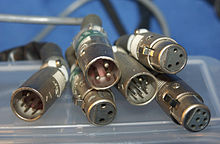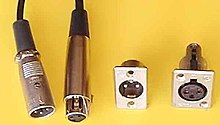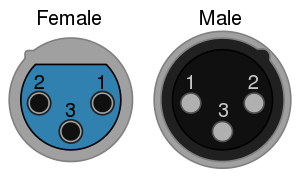XLR connector

The XLR connector is a style of electrical connector, primarily found on professional audio, video, and stage lighting equipment. The connectors are circular in design and have between 3 and 7 pins. They are most commonly associated with balanced audio interconnection, including AES3 digital audio, but are also used for lighting control, low-voltage power supplies, and other applications. XLR connectors are available from a number of manufacturers and are covered by an international standard for dimensions, IEC 61076-2-103.[1] They are superficially similar to the older and smaller DIN connector range, but are not physically compatible with them.
History and manufacturers

The XLR connector was invented by James H. Cannon, founder of Cannon Electric in Los Angeles, California (now part of ITT Corporation), and for this reason it was sometimes colloquially known as a Cannon plug or Cannon connector and in Japan as Cannon jack, though this term has since fallen out of common usage in the industry.[citation needed] Originally manufactured as the Cannon X series, subsequent versions added a latch (Cannon XL) and then surrounded the female contacts with a resilient polychloroprene, which resulted in the part number prefix XLR.[2] There was also an XLP series which used a hard plastic insulation, but was otherwise the same.[3] ITT Cannon originally manufactured XLR connectors in two locations Kanagawa, Japan and Melbourne, Australia. The Australian operation was sold to Alcatel Components in 1992 and then acquired by Amphenol in 1998. ITT Cannon continue to manufacture XLR connectors in Japan.
The Switchcraft corporation later started manufacturing compatible connectors, followed by Neutrik. Neutrik made a number of improvements to the connector and their second-generation design (known as the X-series) had just four parts for the cable connector and eliminated the small screws used by both Cannon and Switchcraft, which were prone to working loose, falling out, and becoming lost. These improvements made Neutrik the most popular brand of XLR connector.
Unbranded XLRs are also made by far-east manufacturers. Originally these were copies of the Cannon or Switchcraft designs, but in recent years the Neutrik designs have also been copied.
Design
XLR connectors are available in male and female versions in both cable and chassis mounting designs, a total of four styles. This is slightly unusual as many other connector designs omit one of the styles (typically a chassis mounting male connector).
The female XLR connectors are designed to first connect pin 1 (the earth pin), before the other pins make contact, when a male XLR connector is inserted. With the ground connection established before the signal lines are connected, the insertion (and removal) of XLR connectors in live equipment is possible without picking up external signals (as it usually happens with, for example, RCA connectors).
The number of pins varies from three to seven. XLR connectors from different manufacturers will intermate, with the exception of Switchcraft 6 pin models, which use a non-standard arrangement for the pins.
Current patterns and applications
Three pin
Three pin XLR connectors are by far the most common style, and are an industry standard for balanced audio signals. In previous years, they were also popular for loudspeaker connections, but they have been superseded by the Speakon connector in this application.
Rechargeable devices exist that use three-pin XLR connectors. These can be found on electric powered mobility wheelchairs and scooters. The connectors carry from 2 to 10 amps at 24 volts.
An obsolete use for three pin XLR connectors was for MIDI data on some Octave-Plateau synthesizers including the Voyetra-8.
Four pin
Four pin XLR connectors are used in a variety of applications.[4]
They are the standard connector intercom headsets, such as systems made by ClearCom and Telex. Two pins are used for the mono headphone signal and two pins for the unbalanced microphone signal.
Another common use is for DC power connections for professional film and video cameras and related equipment. Some desk microphones with LEDs use them. The fourth pin is used to power the LED indicating that the microphone is on. [5] Other uses for the four pin XLR include some scrollers (colour changing devices for stage lighting), AMX analog lighting control (now obsolete) and some pyrotechnic equipment.
Five pin
Five pin XLR connectors are the standard for DMX512 digital lighting control.[6]
Other common uses are for dual-element or stereo microphones (two balanced audio signals with a common ground) and stereo intercom headets (3 pins for the stereo headphone signal - left, right, and ground, and 2 pins for the unbalanced microphone signal).
Six pin
Six pin XLR connectors are used for dual channel intercom systems,[7] and stage lighting control applications.[8][9][10] .
Seven pin
Seven pin XLR connectors are used to connect some valve (tube) condenser microphones to their power supplies (carrying signal, polarisation voltage, heater and HT); and by several models of Le Maitre and Ultratec fog machines for remote control.
An obsolete use for seven pin XLR connectors was analogue lighting control signals.
PDN
The loudspeaker Cannon (known as a PDN connector) had blue or white insulation (depending on its gender), was intended for connections between audio power amplifiers and loudspeakers. These are manufactured by Amphenol (Formally Alcatel Components and ITT Cannon Australia).
Obsolete patterns

Many other types of connectors using the XLR type shell exist, with various pin configurations. Most notable are two now obsolete three-pin patterns manufactured by ITT Cannon.
The power Cannon (also called the XLR-LNE connector) had shrouded pins and red insulation, it was intended as a mains power connector, but has been superseded by the IEC 60320 series of connectors and increasingly, more recently, the PowerCon connector developed by Neutrik.
Two pin
Two pin XLR connectors were used in the 12V DC power supply connection of Yamaha CP-series Electric Grand pianos.[citation needed]
Technical usage information
This section contains more technical information relating the most common applications of XLR connectors.
Three pin - audio


EIA Standard RS-297-A describes the use of the XLR3 for balanced audio signal level applications:

| |
| Pin | Function |
|---|---|
| 1 | Chassis ground (cable shield) |
| 2 | Positive polarity terminal for balanced audio circuits (aka "hot") |
| 3 | Negative polarity terminal for balanced circuits (aka "cold")[11] |
Prior to the introduction of this standard, the wiring of pins 2 and 3 varied. The pin 2 "hot" and pin 3 "cold" convention was typically used by European and Japanese equipment manufacturers, but American companies used pin 3 "hot" and pin 2 "cold". This caused problems when interconnecting equipment with unbalanced connections. The pin 3 "hot" convention is now obsolete but is still found on vintage equipment.[12] Pin 1 has always been ground and/or shield if the cable is shielded, and many connectors connect it internally to the connector shell or case.
Although covered in industry techncial standards, [13] [14] there is still some disagreement on the best way to handle the use of pin 1 for grounding (earthing). The main controversy is whether the shell of the connector should be connected to pin 1 or the shield, or left floating. AES standards mentioned above recommend that shells of cable-mounted connectors should never be connected to pin 1 or the shield, because inadvertent contact of the shell with another grounded surface while in use can create unwanted current paths for fault current, potentially causing hum and other noise. On the other hand, equipment containing active circuitry should always have pin 1 connected to the conductive enclosure of the equipment as close as possible to the point where the signal enters the enclosure. The argument centers around the radio frequency shielding provided by the shell of the connector, which may be reduced if it is left floating. An alternative solution is to connect the shell to pin 1 and the shield through a small value capacitor, providing RF shielding but allowing very little audio-frequency current to flow. This capability can be built into a fixed jack or a cable terminated with XLR connectors.
The standard signal flow for audio is that the output of equipment is a male connector and the input is female. This is the opposite of many other connector standards which normally use female connectors for outputs, a convention influenced by the need to prevent accidental contact with dangerous voltages, for example power sockets. However, the voltages of audio signals are not hazardous and a male XLR is of simpler construction than the female and can easily be incorporated in the body of a microphone.
Since equipment often requires an input on a jack or an XLR connector, Neutrik and Amphenol offer several models of combination connector that accept both XLR and 0.25 in TS or TRS plugs.
Four pin - DC power
The most common standard is for pin 1 to be ground and pin 4 to be 12 volts (nominal), with pins 2 and 3 unused. This configuration is used on most professional video cameras and is also common on audio equipment designed for location use.[4] There are other non-standard arrangements, particularly found on older equipment.
Five pin - DMX512
The 5 pin XLR is the standard connector for DMX512#Connectors, the most common protocol for controlling professional lighting and related equipment.[15]
Additional usage information
At one time XLR3 connectors were also used extensively on loudspeaker cables, as when first introduced they represented a new standard of ruggedness, and economic alternatives were not readily available. The convention[citation needed] was that a two-conductor loudspeaker cable had XLR3 female connectors on both ends, to distinguish it from a three-conductor shielded signal level cable, which has an XLR3 female at one end and an XLR3 male at the other. Either pin 2 or 3 was live, depending on the manufacturer, with pin 1 always the 'earthy' return. This usage is now both obsolete and dangerous to equipment but is still sometimes encountered, especially on older equipment. For example, some loudspeakers have a built-in XLR3M as an input connector. This use was superseded in professional audio applications by the Neutrik Speakon connector.
-
Male and female XLR4 panel connectors
-
Female XLR5 panel connector
-
Female XLR6 panel connector
Phantom power
Some microphones such as condenser microphones require power. An alternative to battery power is phantom power, which consists of direct current applied equally through the two signal lines of a balanced audio connector (in modern equipment, usually an XLR connector). The supply voltage is referenced to the ground pin of the connector (pin 1 of an XLR), which normally is connected to the cable shield or a ground wire in the cable or both. When phantom powering was introduced, one of its advantages was that the same type of balanced, shielded microphone cable that studios were already using for dynamic microphones could be used for condenser microphones as well, in contrast to vacuum-tube microphones, which required special, multi-conductor cables of various kinds.
With phantom power, the supply voltage is effectively invisible to balanced microphones that do not use it: e.g., most dynamic microphones. A balanced signal consists only of the differences in voltage between two signal lines; phantom powering places the same DC voltage on both signal lines of a balanced connection. This is in marked contrast to another, slightly earlier method of powering known as parallel powering or T-powering (from the German term Tonaderspeisung), in which DC was overlaid directly onto the signal in differential mode. Connecting a dynamic microphone (especially a ribbon microphone) to an input that had parallel powering enabled could very well damage the microphone severely, but this is not normally so with phantom powering unless the cables are defective or wired incorrectly.
XLD keyed variant
The XLD connector' is a keyed variant of the XLR connector. The keys prevent accidental mixing of XLR and XLD connectors. XLD plugs and sockets are used mostly in professional audio and video electronics cabling applications.
The XLD connector is used with the Audio Engineering Society AES42 digital microphone interface standard.
The connectors are similar to XLR but with an extra coding key and groove that allows control over the intermating of XLD plugs and XLR sockets. A connector with the coding key installed will not mate with a connector that does not have the matching groove.[16] By suitably keying connectors, analog microphones can be protected from damage by the high current digital phantom power supply provided for digital microphones.
See also
References
- ^ "IEC 61076-2-103 ed1.0. Connectors for electronic equipment - Part 2-103: Circular connectors - Detail specification for a range of multipole connectors (type 'XLR')". International Electrotechnical Commission. 03-August-2004. Retrieved 2012-03-23.
{{cite web}}: Check date values in:|date=(help) - ^ Rane Professional Audio Reference description
- ^ Rayburn, Ray (December 16, 2008). "A brief history of the XLR connector". Sound First. Archived from the original on February 22, 2011.
{{cite web}}: Unknown parameter|deadurl=ignored (|url-status=suggested) (help) - ^ a b http://pinouts.ru/Home/xlr4_pinout.shtml
- ^ http://www.sennheiser.com/sennheiser/home_en.nsf/root/professional_wired-microphones_installed-sound_504792?Open&row=2
- ^ "DMX (DMX512) pinout". Retrieved 2012-03-08.
- ^ "Clear-Com RS-602 beltpack". Retrieved 2012-03-16.
- ^ "ETCLink Documentation".[unreliable source?]
- ^ "ETC RFU Documentation".[unreliable source?]
- ^ "ETC RFU and ETCLink Pinout".[unreliable source?]
- ^ Audio Engineering Society. AES14-1992 AES Standard for professional audio equipment—Application of connectors, part 1, XLR-type polarity and gender.
- ^ "3-Pin XLR Audio Pinout". Clark wire and cable. Retrieved 2012-03-12.
- ^ AES48-2005
- ^ AES54-3-xxxx,
- ^ "DMX512 Standard Pinouts". Retrieved 2012-03-12.
- ^ Don Davis, Eugene Patronis Sound system engineering Third edition, Focal Press, 2006 ISBN 0-240-80830-4, page 448



